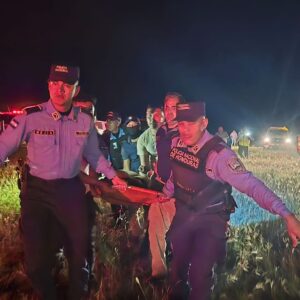Over the past 12 months, an Alaskan volcano named Mount Spurr has become noticeably agitated: It’s been swelling, quaking, and venting noxious gases. As it stands today, the evidence could point to a major explosive event on the horizon—or the mountain might just be harmlessly blowing off some steam.
If an eruption were to happen, the good news is that there aren’t any communities living on its slopes that would be smothered by scalding avalanches of rock and vapor. The bad news is that such an eruption would likely generate a plethora of ash—and if the wind blows to the east that day, the city of Anchorage about 80 miles away would see the worst of it.
“Ashfall is going to be a big hazard,” says Matt Haney, the scientist-in-charge at the U.S. Geological Survey’s Alaska Volcano Observatory.
Though volcanic ash might sound exceptionally perilous for humans, it’s less dangerous than you might thing. Instead, ash from Alaskan volcanoes poses a significant hazard for airplanes above all else, as it can quickly melt and stall their engines. An eruption at Mount Spurr, then, would not only require diverting all flights away from the region; it would also necessitate shutting down Anchorage’s busy international airport, which could cause serious economic damage.
Mount Spurr’s hazards could extend beyond threatening airplanes. Depending on the amount of ash produced, and where it lands, it could become an issue to people, infrastructure, and the wider environment. Here’s everything you need to know about why the volcano has been so restless and what to expect from an eruption.
(Here’s the science behind Santorini’s mysterious quakes.)
Mount Spurr’s shaking and quaking
Mount Spurr has two key eruptive vents: one at the 11,000-foot summit, which appears to have been sealed shut for thousands of years, and one nearby, named Crater Peak, which has exploded multiple times in the past few millennia. The last eruption took place in 1992, featuring three distinct explosions.
Spurr is known to exhibit earthquakes without consequence. But in late-April 2024, the quake frequency rose while the volcano began to swell up—a phenomenon where the ground literally inflates. Things quietened down in the summer before getting more agitated again in the fall. And by mid-October, with the volcano continuing to inflate and trembling rather dramatically, the Alaska Volcano Observatory issued an alert: Something unusual was going on.
“There’s a magma intrusion causing the volcano to inflate, causing those earthquakes,” says Haney. The observatory changed the aviation notice from green (the volcano is acting normally) to yellow (the volcano is exhibiting signs of elevated unrest). In other words: The volcano might be gearing up for an eruption, and its ash cloud would endanger any planes in the vicinity.

Through January and February, quakes continued to be frequent (and sometimes intense), and more began to cluster beneath Crater Peak. In March, things escalated even further: both carbon dioxide and sulfur dioxide began to gush out of the summit, while only carbon dioxide was detected around Crater Peak. These gases are known to escape from magma as it rises and depressurizes—and these readings indicated that magma was very close to the summit, while being somewhat deeper below Crater Peak.
Despite its proximity to the summit, volcanologists were more concerned that magma was close enough to Crater Peak—which, in modern times, is the vent that ultimately explodes—to make it at least somewhat gassy. All these signals together indicated that “the conduit beneath Crater Peak has been activated,” says Haney.
As of May, things have calmed slightly. The gas emissions have persisted, but the volcanic inflation has slowed a little and the quakes are a little less frequent. Things could continue to climbdown from here on out. “A failed eruption, where the magma stalls and does not reach the surface, as happened in 2004–2006, is also a possibility,” says David Fee, a volcanologist at the University of Alaska Fairbanks.
Alternatively, things could ramp up again, ending in an explosion, likely from Crater Peak. And that would probably produce an ash cloud that would rise tens of thousands of feet into the sky.
The immediate risks of an eruption
Those in Anchorage would not be in any immediate, life-threatening danger. “You’re not living on the volcano, you’re not going to be inundated by a pyroclastic flow,” says Michelle Coombs, a research geologist for the Alaska Volcano Observatory.
The problem, though, is that a Crater Peak blast, or succession of blasts, “each lasting as long as a few hours, would produce ash clouds carried downwind for hundreds of miles and ashfall over southcentral Alaska,” says Fee.
Before it falls from the sky, though, it will linger at altitude—and any planes in the region will need to be hastily diverted. Unlike the ash in wildfire smoke, it’s not made of burned organic material. Volcanic ash is hard, sharp and glass-like. It’s not only abrasive, but also capable of melting inside jet engines, causing them to fail. Cabin windows can be blocked up and eroded, and a plane’s electronic circuitry can be disturbed.
Two modern eruptions from Crater Peak—one in 1953, and the episode in 1992—both deposited ash on Anchorage. One of the 1992 explosions dumped one-eighth of an inch of ash on Anchorage, and the airport closed for 20 hours. “It was a big deal then. If it happens today, it’ll be an even bigger deal,” Haney says, noting just how much more air traffic goes through the city in 2025.
Fortunately, a Spurr explosion would not be reminiscent of the 2010 eruption of Iceland’s Eyjafjallajökull volcano, which caused the biggest shutdown of European airspace since the Second World War. An explosive episode at Crater Peak would last only a few hours—meaning the airspace would only be briefly affected. Still, Anchorage’s international airport is the fourth-busiest cargo airport in the world, so any shutdown would be highly disruptive.
How volcanic ash can (and can’t) endanger people
If much of that ash does eventually descend upon Anchorage, it would certainly be unpleasant, not least because of its ominous appearance. “It darkens the skies, it makes it turn night in the middle of day,” says Haney. And although volcanic ash rarely endangers human life, it can be problematic in several ways.
“Ash in the air is a respiratory hazard, and can also irritate exposed eyes and skin,” says Carol Stewart, a disaster environmental health specialist at Massey University in New Zealand. Vulnerable groups—the very young and the elderly, and those with pre-existing cardiovascular or respiratory conditions—may feel this irritation more strongly. Prolonged exposure may lead to hospital admissions for some, but for the most part, ash inhalation is a nuisance, not a lethal danger.
As for other animals, “ash impacts on livestock are quite similar to impacts on people in terms of eye, skin and airway irritation,” says Stewart. Unsurprisingly, if they eat ash, it can have deleterious effects on their health. “Ash will also cover pasture so that they will need supplementary feeding, and it can contaminate their water sources.”
Volcanic ash can cause power outages, either through short-circuiting electrical circuits or weighing down tree branches so much they fall onto power lines. It also often blankets rooftops and, because it’s dense, it can in some rare cases cause rooftops to buckle and collapse. But that requires remarkably high volumes of ash—much higher than Spurr’s typical production levels.
The greatest risk ash poses may be to drivers. “Ash on roads makes for hazardous driving conditions,” says Stewart. “The ash leads to a loss of traction, it covers up the road markings, and it also gets lifted into the air, impairing visibility. Accidents are common after ashfall.” The air filters on cars can also quickly clog up.
Because ash contains a lot of iron and aluminum, significant quantities can make water undrinkable, although not outright poisonous. The work of removing these particles from the water can cause water production to grind to a halt, while demand for water spikes as people use it to wash all the ash off their homes, cars and driveways. “Running out of water is a much greater health risk than minor chemical changes to the water,” says Stewart.
(Meet the volcanologist who changed how scientists see volcanoes.)
The days to come
All things considered, the disruption to air traffic is the primary hazard from an ash-heavy Spurr eruption, says Haney. Based on Crater Peak’s historical explosive episodes, people in Anchorage should not be overly concerned about the other, more minor effects of the volcano’s ashfall.
But that doesn’t mean they shouldn’t be prepared to deal with it. According to the U.S. Geological Service, if ashfall is forecast, residents should stay at home, move pets indoors, put vehicles under cover, and make sure to keep anyone with respiratory or cardiovascular conditions safe and close to their medical supplies. If you are caught outside, use a face mask or cloth to avoid breathing the ash in, and seek shelter.
At this stage, it isn’t clear if an eruption is inevitable. If scientists detected an uptick in the rate of volcanic inflation, a lot more volcanic outgassing, a significant melting of snow and ice, and a swarm of earthquakes suggesting magma was rising and effortlessly breaking rock, “that would be a no-brainer,” says Haney. At that point, they would raise the aviation alert level to orange, indicating an increased potential of an eruption.
But even then, an explosion isn’t guaranteed. If one were inevitable, the timeframe would still be unclear: This intense degree of unrest could be brief, but it could also last for several weeks, or months, before an eruption occurs.
One day, ash jettisoned from Mount Spurr will once again blanket Anchorage. But will that be sooner, or later? “We’re in a watching and waiting mode right now,” says Coombs.





